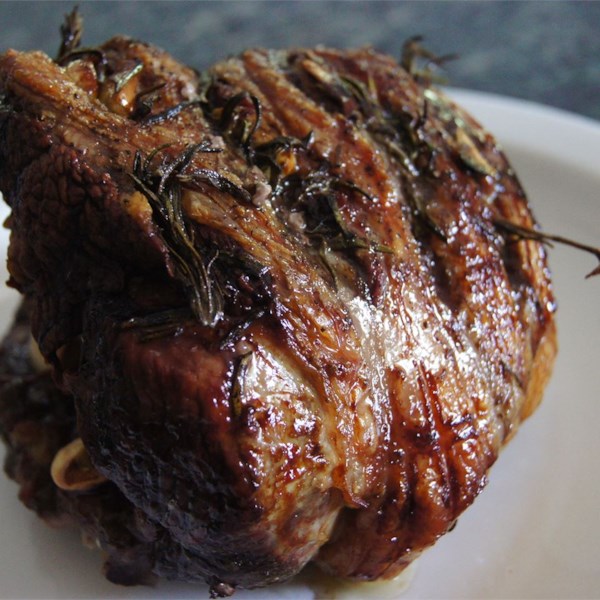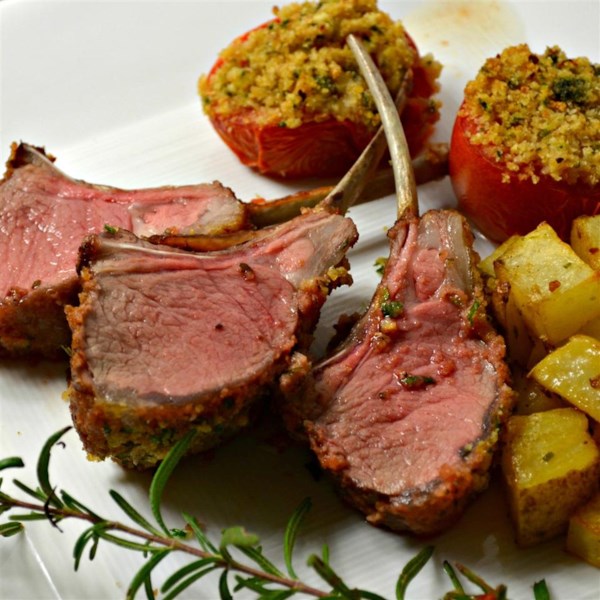Get the cooking times and preparation tips you need to make perfectly roasted lamb: crisp on the outside, tender and juicy on the inside.

Photo by TheBritishBaker
Roasting is a “dry heat” cooking method, meaning that you do not add any liquid to the meat as you cook it. Dry heat is best for cuts of meat that are naturally tender.
Choosing the Right Cut
The leg and rack are the most tender cuts of meat on a lamb. Rack of lamb is often served “Frenched,” with the fat and meat trimmed from between the ribs and the bones scraped clean and protruding outward. Your butcher should be able to do this for you; ask for the meat trimmings to make soup later on.

Photo by Kim’s Cooking Now!
- Roasted Rack of Lamb
- Lime Glazed Leg of Lamb
- Stuffed Leg of Lamb with Balsamic-Fig-Basil Sauce
- Roast Leg of Lamb with Rosemary
- Holiday Leg of Lamb
- Easy Roast Leg of Lamb
Seasoning the Meat
Lamb is flavorful enough on its own that it doesn’t need much seasoning, yet robust enough that it pairs beautifully with any number of boldly flavored seasonings, like rosemary, oregano, marjoram, thyme, lemon zest, cumin, coriander, mint, and garlic.
- Before seasoning the lamb, trim some of the excess fat and any silver skin.
- Chop up herbs/seasonings and rub the mixture evenly over the surface of the meat.
- Wrap the coated meat tightly in plastic wrap and refrigerate overnight for the best flavor.
Another popular way to season a roast is to make small incisions in the surface of the meat and push slivers of garlic and sprigs of herbs into the slits. You can do this right before you begin roasting or a day ahead for more intense flavor.
Season the lamb however you like–but don’t salt it until just before cooking, as salt can draw moisture out of the meat.
Roasted to Perfection
Before roasting your lamb, remove it from the refrigerator and allow it to sit for 30 minutes. A piece of meat at room temperature will roast more evenly.
Use a roasting rack to ensure even browning and heat circulation around the meat.
The amount of fat that your lamb has on the outside and marbled through the middle will determine the cooking time and temperature:
- For a lean piece of meat, cook at 450 degrees F (230 degrees C) for the first 15 minutes, then turn the temperature down to 350 degrees F (175 degrees C) to continue roasting–the meat will take about 25 minutes per pound to reach medium rare.
- Using a hot oven gets leaner cuts of meat nicely browned on the outside before they become overcooked and dry in the middle.
- For a fattier piece of meat, roast at 325 degrees F (160 degrees C) for a longer period of time, allowing the fat to slowly melt and bathe the roast in its own juices. Meat cooked with this method will take about 30 minutes per pound to reach medium rare.
The most accurate way to determine doneness is with a meat thermometer:
- 110 degrees F (42 degrees C) is rare
- 120 degrees F (58 degrees C) is medium-rare
- 145 degrees F (68 degrees C) is medium-well
Avoid cooking your lamb beyond this temperature as the meat can become dried out and tough. For safety, the USDA recommends cooking roasts to 145 degrees F.
Rest Your Roast
Once your roast is within 10 degrees F (5 degrees C) of its ideal cooked temperature, remove from the oven, place a foil tent loosely over it, and let rest for 15-20 minutes. As the meat rests, the internal temperature will increase by several degrees, the muscle fibers will relax, and the juice that has come to the surface of the meat during cooking will begin to return to the center. A well-rested piece of meat will be more tender and retain its juices better when you slice it.
The post How To Roast Lamb appeared first on Allrecipes.